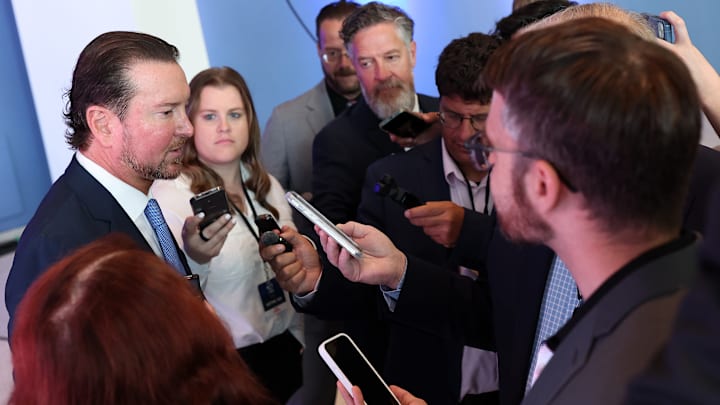On Tuesday, the NASCAR Hall of Fame announced its three inductees for the Class of 2026. They are Kurt Busch, Harry Gant, and Ray Hendrick.
Gant was an 18-time Cup Series race winner, while Hendrick, no relation to legendary car owner and fellow Hall of Famer Rick, was a local short track icon. But it's Busch, a first-ballot inductee, who is likely the most well-known to modern NASCAR viewers.
The 2004 Cup Series champion and 2017 Daytona 500 winner owns a complicated legacy, both on and off the track. Ultimately, there is one superlative that perhaps best describes him: NASCAR's greatest antihero.
🏆🏁 Your 2026 NASCAR Hall of Fame class: Kurt Busch, Harry Gant and Ray Hendrick! pic.twitter.com/zQ5pr1WVBO
— FOX: NASCAR (@NASCARONFOX) May 20, 2025
Kurt Busch wasn't your typical NASCAR black hat
Busch is the type of driver whose career cannot be properly evaluated through stats alone. Rather, it must be viewed as a journey of resilience, perseverance, and harsh lessons learned; the story of a man who experienced both the highest highs and the lowest lows that come with being human.
In the early 2000s, the only thing faster than Busch's meteoric emergence into the upper echelon of Cup Series talents was his rise up the list of the circuit's most hated drivers. He was considered arrogant and hot-headed, and he found himself frequently embroiled in controversy, most notably in the form of a recurring feud with veteran driver Jimmy Spencer.
A year after Busch became the inaugural champion of the Chase for the then-Nextel Cup in 2004, he was released from his contract with Roush Racing following an Arizona arrest for reckless driving and suspicion of DUI. Six years later, the Las Vegas native met another unceremonious ending with Team Penske following a garage area tirade at Homestead-Miami Speedway.
At that point, Busch had all but blacklisted himself from teams and sponsors alike, and he began the 2012 season driving for the underfunded Phoenix Racing. That year would be rock bottom for his Cup Series career as he frequently struggled to keep his cool, all while stumbling to a 25th place points finish.
He was so unhinged that Spencer, his former nemesis-turned-TV analyst, ran a frequent Speed Channel segment dubbed "Kurt Busch: Radio Sweetheart", complete with a mock "crying towel" for the driver's blowups.
He left Phoenix Racing for fellow small-time team Furniture Row Racing late in 2012, and slowly, something began to change. A new version of Busch emerged, a humbler, more refined one, with a visible gratitude for the opportunities he still had.
His results on the track turned around as well, making the playoffs for Furniture Row in 2013, and upon joining Stewart-Haas Racing in 2014, he snapped a three-year winless skid at Martinsville Speedway.
Busch would win nine more times in the Cup Series with two additional race teams, and through it all, something crazy happened: people started rooting for him. In the latter stages of his career, he became known as one of the most well-respected veterans in the garage, all while a certain human element attached itself to his image, a product of the many trials and tribulations he had endured.
Even during his peak heel days, Busch was different from most other villains in that he could never hide his more vulnerable side. He was less of a "bad guy" as he was someone who wanted to be a good guy, but made some mistakes that he was forced to pay the price for, and grow from. All of that shaped him into one of NASCAR's most fascinating figures, someone whose quest for redemption was all too relatable.
Sadly, Busch would be delivered one more fateful setback, when he suffered a career-ending head injury during a qualifying crash at Pocono Raceway in 2022. He never got to retire from NASCAR competition on his own terms, and the official closure and vindication for his journey would have to be put on hold.
That is, until now. The Cup Series legend will be forever enshrined in NASCAR history along with the rest of his class in January 2026. It's an honor well-deserved not only for Busch, the driver, but for Busch, the person.
